Consume more local produce with whole food smoothies
Smoothies are a perfect vehicle for nutritional goodness, but it can be easy for smoothies, meant as a snack or meal, to become loaded with sugar, artificial sweeteners and plenty of ingredients you probably can’t pronounce. The most satiating smoothies will include some protein, healthy fat and complex carbs. Having this combination will be satisfying and deliver you optimal nutrients. Let’s put it into practice.
Summer of Lovage
Forget Parsley, Sage, Rosemary and Thyme! Lovage, with its bright celery and anise notes, can be added to everything from salads to soups all season long!
Nasturtium Chips are a Fun, Easy Way to Enjoy Edible Flowers
Not only do nasturtiums make a colorful and easy addition to any Inland Northwest garden, but all parts of the plant are edible, too. The nasturtium’s iconic round leaves can be baked to create chips that are similar in shape and size to classic potato chips and carry a brittle crunch like seaweed snacks.
Searching for Sparrow Grass: On the Hunt for Wild Asparagus in the Inland Northwest
Foraging for wild asparagus will add flavor to your meals, make for a beautiful day out on the Spokane River and save your money. Take advantage of these tasty plant shoots and incorporate them into your next recipe.
Rosehips: A Tasty Winter Reminder of Beautiful Summer Blooms
Rosehips are the fruit you see hanging from rose bushes across the Inland Northwest after the flowers and leaves fade away in autumn. After a few frosts, rosehips become sweet and tender. Perfect for topping many desserts, you can purée them fresh and use them as a sauce over cake and ice cream or dry them and use for tea.
I Hate Huckleberries
Huckleberries are a popular summer staple across the Inland Northwest, but after a career of having to use them in beers and BBQ sauce, Joshua Martin explains why he hates this forageable fruit.
Garlic: Plant This Pungent Bulb in Fall and Enjoy Next Summer
While many vegetables are planted in spring, it is important to plant garlic in fall. Most varieties of garlic need a few months of winter weather to produce strong and large bulbs that will be ready to enjoy come summer!










